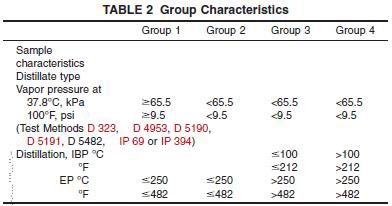ASTM D86 for distillation of petroleum products at atmospheric pressure
7. Sampling, Storage, and Sample Conditioning
7.1 Determine the Group characteristics that correspond to the sample to be tested (see Table 2). Where the procedure is dependent upon the group, the section headings will be so marked.

7.2 Sampling:
7.2.1 Sampling shall be done in accordance with Practice D 4057 or D 4177 and as described in Table 3.

7.2.1.1 Group 1 - Condition the sample container to below 10°C, preferably by filling the bottle with the cold liquid sample and discarding the first sample. If this is not possible because, for instance, the product to be sampled is at ambient temperature, the sample shall be drawn into a bottle prechilled to below 10°C, in such a manner that agitation is kept at a minimum. Close the bottle immediately with a tight-fitting closure. (Warning - Do not completely fill and tightly seal a cold bottle of sample because of the likelihood of breakage on warming.)
7.2.1.2 Groups 2, 3, and 4 - Collect the sample at ambient temperature. After sampling, close the sample bottle immediately with a tight-fitting closure.
7.2.1.3 If the sample received by the testing laboratory has been sampled by others and it is not known whether sampling has been performed as described in 7.2, the sample shall be assumed to have been so sampled.
7.3 Sample Storage:
7.3.1 If testing is not to start immediately after collection, store the samples as indicated in 7.3.2, 7.3.3, and Table 3. All samples shall be stored away from direct sunlight or sources of direct heat.
7.3.2 Group 1 - Store the sample at a temperature below 10°C.
NOTE 6 - If there are no, or inadequate, facilities for storage below 10°C, the sample may also be stored at a temperature below 20°C, provided the operator ensures that the sample container is tightly closed and leak-free.
7.3.3 Group 2 - Store the sample at a temperature below 10°C.
NOTE 7 - If there are no, or inadequate, facilities for storage below 10°C, the sample may also be stored at a temperature below 20°C, provided the operator ensures that the sample container is tightly closed and leak-free.
7.3.4 Groups 3 and 4 - Store the sample at ambient or lower temperature.
7.4 Sample Conditioning Prior to Analysis:
7.4.1 Samples shall be conditioned to the temperature shown in Table 3 before opening the sample container.
7.4.1.1 Groups 1 and 2 - Samples shall be conditioned to a temperature of less than 10°C (50°F) before opening the sample container.
7.4.1.2 Groups 3 and 4 - If the sample is not fluid at ambient temperature, it is to be heated to a temperature of 9 to 21°C above its pour point (Test Method D 97, D 5949, or D 5985) prior to analysis. If the sample has partially or completely solidified during storage, it shall be vigorously shaken after melting prior to opening the sample container to ensure homogeneity.
7.4.1.3 If the sample is not fluid at room temperature, the temperature ranges shown in Table 3 for the flask and for the sample do not apply.
7.5 Wet Samples:
7.5.1 Samples of materials that visibly contain water are not suitable for testing. If the sample is not dry, obtain another sample that is free from suspended water.
7.5.2 Groups 1 and 2 - If such a sample cannot be obtained, the suspended water can be removed by maintaining the sample at 0 to 10°C, adding approximately 10 g of anhydrous sodium sulfate per 100 mL of sample, shaking the mixture for approximately 2 min, and then allowing the mixture to settle for approximately 15 min. Once the sample shows no visible signs of water, use a decanted portion of the sample, maintained between 1 and 10°C, for the analysis. Note in the report that the sample has been dried by the addition of a desiccant.
NOTE 8 - Suspended water in hazy samples in Groups 1 and 2 can be removed by the addition of anhydrous sodium sulfate and separating the liquid sample from the drying agent by decanting without statistically affecting the results of the test.4
7.5.3 Groups 3 and 4 - In cases in which a water-free sample is not practical, the suspended water can be removed by shaking the sample with anhydrous sodium sulfate or other suitable drying agent and separating it from the drying agent by decanting. Note in the report that the sample has been dried by the addition of a desiccant.



